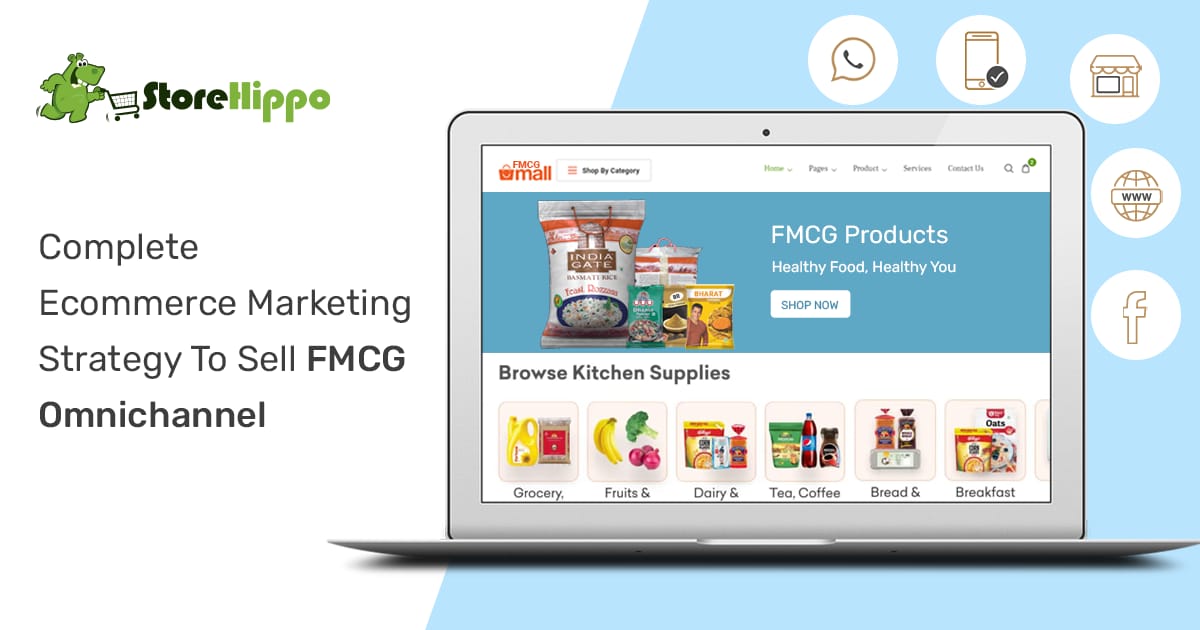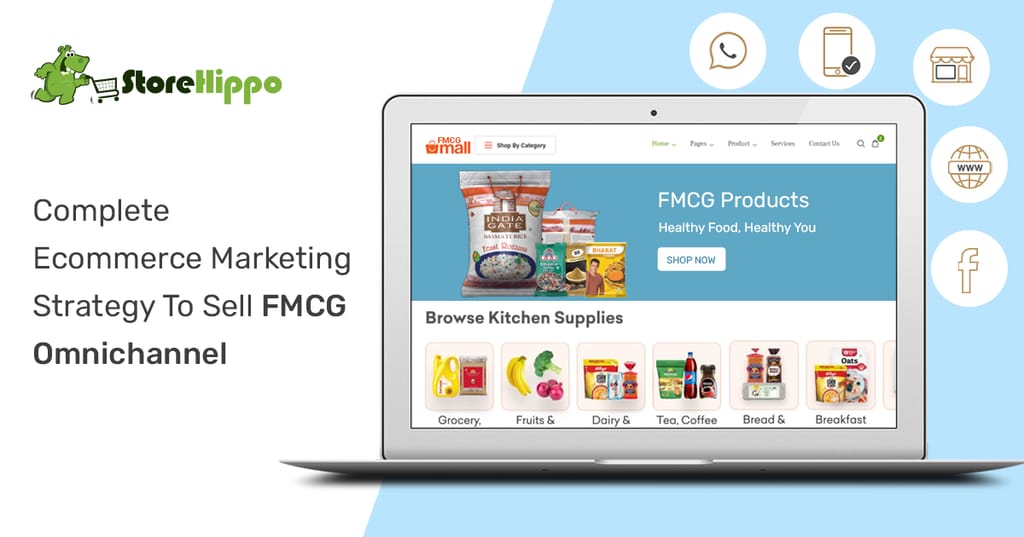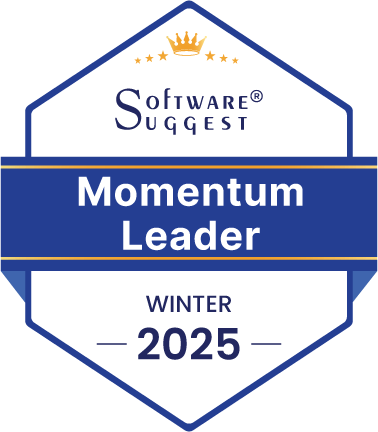Want to grow the online reach and visibility of your FMCG ecommerce brand? Want a way to build a large customer base and generate revenue by leveraging multiple channels of marketing? Well, there is one effective way to achieve all of these i.e. omnichannel ecommerce marketing.
Whether you sell groceries or office supplies or beverages or personal care items or consumer electronics or medicines or any other fast-moving consumer goods (FMCG), following an omnichannel retail approach will help you reap benefits in the long term.
This is because 96% of consumers have adopted new shopping behavior (shopping on multiple channels) and approximately 60% are expected to shift to online channels for buying.
What is omnichannel marketing?
It is a practice to reach customers spread across various channels in order to give a phenomenal customer experience whenever they come in contact with the brand.
Table of Contents
- How to plan an ecommerce marketing strategy for FMCG brands?
- Examples of FMCG brands with powerful omnichannel marketing strategy
- Ecommerce platform features for running a successful FMCG ecommerce marketing
- Final Takeaways
How to plan an ecommerce marketing strategy for FMCG brands?
Before moving to plan, let’s first know about the prerequisites for building a successful omnichannel ecommerce marketing. They are-
Data about Customer touchpoints (Offline and digital)
Customer Data like their email address, purchase history, browsing history, etc
Data about competitors
An ecommerce platform with a headless ecommerce framework
How to collect this data? Here are the steps to collect requisite data to kickstart your ecommerce marketing plan for FMCG.
1. Study customer shopping behaviour and collect data
Start by creating a buyer persona or target customer for your FMCG brand. A buyer persona will give you clarity on what type of customers to target.
What to include in the buyer persona?
Professional information: Job Title, Job Description, Company Industry, Company Size, KPIs
Demographics: Age, Gender, Location, Education, Family, Personal Background, Skills
Behavior: Personal Traits, Shopping Preferences
Personal preferences: favorite days of shopping, preferred social media platforms, channels of shopping (online or offline)
How to collect customer data for building a Buyer Persona?
The best ways to create a buyer persona are-
- Digital advertising: Run Facebook ads and Google Ads campaigns to find out what type of customers are interacting with your ads and purchasing your FMCG products.
Tip: Try location-based advertising where you can target a particular location (country, city, state, Pincode).
Keywords research: Find the number of monthly searches on Google for the products you're selling in a target country. For example, ‘’online grocery” gets 33,100 searches per month in India. By doing this, you can know the online demand for your products
Newsletter subscription: Start an email newsletter subscription, display it on your website and ask website visitors to give their email addresses to get discounts, sale alerts, product launches, etc
Pro-Tip: To increase the subscription rate, add an incentive at the time of signing up for a newsletter. Like bonus points or coupon codes using which they can shop on your online store.
Interview customers: Forward a survey form to your current customers who have purchased your products. Ask them about their gender, income range, hobbies, monthly shopping needs, shopping channels, etc
Watch competitors followers: Stalk the followers of your competitors by leveraging their social media. Analyze what type of customers are liking and commenting on their posts
Study site traffic: Website visitors that land on your online store is also the best source for data collection
Apart from collecting data to know your customer, you should also know their customer purchase journey. Let’s have a quick glimpse of the general FMCG buyer journey - Problem or need recognition > Searching for the best solution online > Evaluation of alternatives > Purchase > Post-purchase behavior
This helps in planning the right engagement strategy at each stage.
2. Research your FMCG competitors
Find out what your competitors are doing to attract and convert customers. You can find answers to questions -
What ecommerce marketing strategies are they using? Like influencer marketing, social media marketing, SEO, media buying, media buying, or any other type of marketing
What channels are they using to promote their FMCG products?
Best FMCG ecommerce marketing channels are website, app, mobile website, Facebook and Instagram account,
- What social media platform are they active on?
Search them on Facebook, Youtube, Instagram, Snapchat, TikTok, Pinterest, and Twitter. Collect insights on what type of contempt they are posting
- Are they leveraging paid ecommerce marketing for better awareness and sales? For example - influencer marketing, media advertising, Facebook advertising, youtube advertising, affiliate marketing, etc.
After you have found the answers, move to the next step.
3. Determine your ideal channels
If you’re looking to get started with omnichannel marketing, first determine which marketing channels are best for your FMCG brand so that you can communicate better with your audiences. Imagine every possible experience that a consumer desires. They might desire:
Relevant marketing emails
Product recommendations on app/website
Easy and quick checkout with the availability of their favorite payment method
Quick resolution of grievances/doubts over social media platforms
Relevant advertisements on various channels
4. Build marketing plan (with strategies) to provide a tailored shopping experience
1. Personalized e-commerce marketing:
Customers love FMCG brands that offer a relevant and hyper-personalized shopping experience. So here are the strategies to consider-
Send relevant email and push notifications (for app users) to notify your customer about new products, festive sales, discount on wishlist items/cart items, delivery status, order confirmations, etc
Create Dynamic Marketing pages unique to a set of buyers located in a particular location. StoreHippo ecommerce platform offers readymade templates to create dynamic pages fast
Implement a product recommendation feed that is unique to each buyer based on their purchase history, view history, cart items, etc
2. D2C marketing:
Sells FMCG products directly to consumers by striking out the middlemen/distributors that significantly lower your profit margins and hurts customer shopping experience. With a D2C marketing strategy, you can easily acquire customer data and deliver them unique, tailored experiences because you have complete control of brand messaging and customer service.
Tip: To win D2C selling, focus on offering low prices that balance with the product utility and create a personalized customer journey across every channel (on which they come in contact with your brand).
3. Mobile commerce marketing:
As billions of people have access to the internet and smartphone, shopping from mobile has also inflated. Take this growth as an opportunity to bring mobile buyers to your store, by optimizing your store for mobile devices. Focus on your loading speed, device responsiveness, offering mobile wallets during checkouts, etc.
4. Localized content marketing:
Businesses that localize content can expect to see higher conversion rates and improve customer satisfaction.
How to offer localized content?
All your product descriptions, product recommendations, FAQs, user guides, price, etc should be localized in the language and currency of the customer’s country. Through an ecommerce platform like StoreHippo that offers multi-currency and multilingual features to increase content relevancy to your target audience.
Examples of FMCG brands with powerful omnichannel marketing strategy
FMCG brands like Reliance Retail, DMart, and Future Group have dominated the FMCG market for a long era, but soon after the emergence of ecommerce stores like Amazon, Flipkart, Nykaa, Myntra, their monotony has broken. Do you know how they disrupted the FMCG industry? Let’s learn about their strategies-
1. Nykaa
Till now Nykaa has a huge wealth of regular customers which they collected via social media channels, an ecommerce website, email marketing, and media channels. The products listed in their store are for everyone (luxury buyers or budget buyers).
Apart from its online presence, they also have 41 outlets across 18 cities in India. Both online and offline channels are well connected in helping customers make purchase decisions by trying the products and then buying them online.
2. Myntra
Selling FMCG products like apparel has made them the best fashion marketplace for men, women, and kids. Let’s explore their winning strategies:
Channels that helped them attract millions of customers are- social media channels, offline advertising, Facebook Ads, Google Ads, Youtube channels, mobile app, website, etc
To keep the new customers engaged with the platform, they included the following sales magnets in their marketing mix- free shipping, cash on delivery, a 30-days return policy, relevant emails, customized in-app notifications, loyalty points on every purchase, End of Reason Sales, 10%-80% discounts, and even more
Ecommerce platform features for running a successful FMCG ecommerce marketing
Create FMCG sub-stores for each location from a single dashboard and direct your customer to the sub-store nearest to their geolocation. You can also create product category-based stores for a better marketing message. Like grocery stores for household items, personal care stores for cosmetics, haircare, personal hygiene items.
Mobile commerce
Create mobile apps for both Android and iOS users and give a friction-free shopping experience.
Customizable themes
Get access to 100+ beautiful themes that are 100% editable and mobile-friendly.
Marketing tools
Get dedicated marketing tools such as discount engines for creating discounts/coupons, SEO tools to rank higher on search engines, and dynamic marketing pages to appeal to local audiences.
Integrated payment gateways
Give different payment gateways based on the geographical location of customers and hence, smoothen your checkout process.
Reliable shipping solution
Deliver to anywhere in the country with StoreHippo shipping solution Shipkaro. It offers a list of delivery partners that can be set up within a few clicks.
Third-party integration
Integrate your core business software like ERP solution, POS, CRM, accounting software, and marketing tools to your ecommerce platform.
Final Takeaways
The macro shift in consumer and FMCG brand relationships has been accelerated over the past several months. Hence, it is important to develop a future-friendly FMCG ecommerce marketing to build a brand reputation as well as revenue. Let's sum up the points we have learner so far:
Collect buyer's data and use it to develop a personalized experience for each type of buyer, landing on your website or any other channels
Create an “Always On” Digital Marketing Strategy that aligns with marketing and product delivery promises
Leverage the latest ecommerce technology by using an advanced ecommerce platform like StoreHippo
Generate better content and reduce production costs by creating a full picture of your core customers
Is your marketing strategy set to meet ever-changing customer expectations? Are you ready to convert more potential FMCG customers? If yes, then you need an ecommerce platform that should have inbuilt marketing tools and must support the integration of the other third-party marketing tools.
Luckily, you don’t have to search for platforms as the StoreHippo ecommerce platform offers every feature you need in implementing your marketing plan.
Want to experience StoreHippo features in real-time? Get started with a 14 days free trial to try StoreHippo’s advanced features.





















Leave A Comment